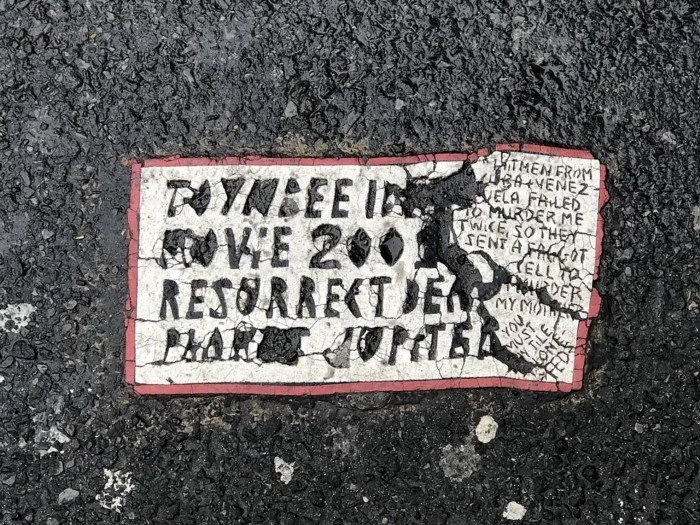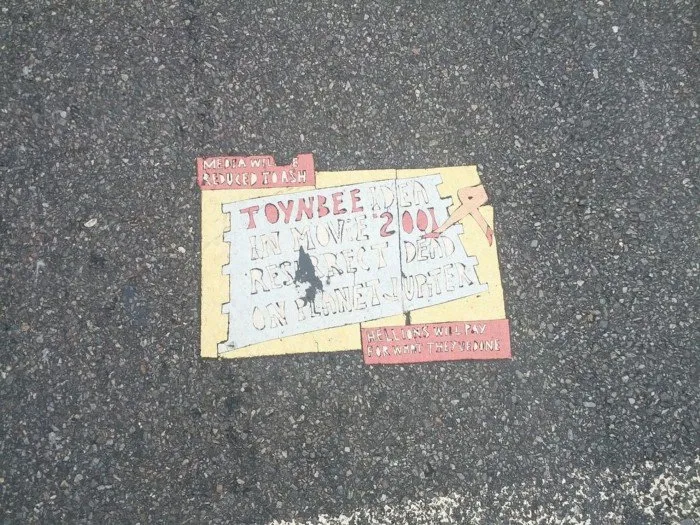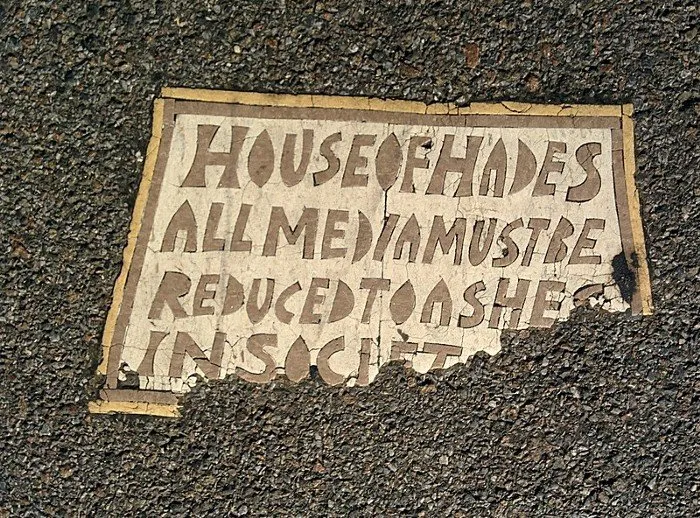
Wikipedia Commons, W 43rd St. Manhattan
Imagine you’re walking along one day when your shoe catches on something. When you look down to see what it was, you’re met with a strange sight. There, firmly embedded in the asphalt, is a placard of some kind reading “TOYNBEE IDEA MOVIE 2001 RESURRECT DEAD ON PLANET JUPITER”.
What in the farm fresh, flavor blasted McHell? Your confusion is understandable. When these tiles began appearing in about two dozen US cities and four South American cities in the 1980s, they captured the public’s imagination immediately. What could it mean?
Variations on the main message furnish some clues, the differences in wording providing those who would interpret these ravings with a foothold from which to discern the author’s intended meaning. For example some of the tiles explicitly confirm that “movie 2001” does indeed refer to the Stanley Kubrick film:

Wikipedia Commons, 13th & Market Street, Philadelphia
As the internet took off in the 1990s, awareness of the Toynbee tile phenomenon spread, and with it popular speculation as to the identity of the author. Whoever he was, he really got around, and seemed determined to get his message out. With the film reference deciphered, the next step was to interpret “TOYNBEE IDEA” and “RESURRECT DEAD ON PLANET JUPITER”.
The latter is most widely held to reference the endings of 2001: A Space Odyssey and 2010: The Year We Make Contact wherein Dave is reborn as a star child, Jupiter transformed by uncountable monoliths into a new star, rendering Europa (more) habitable.
If you’re satisfied that explanation lines up, that’s another third of the message deciphered. Some dispute this approach, claiming Jupiter is in fact a reference to Jupiter Brains, a hypothetical computational megastructure which (among other things) could be used to run historical simulations, recreating long deceased persons.

Wikipedia Commons, 4th & H Streets NW in Washington DC
To me that reads as an indefensible, if imaginative, stretch. I’m personally satisfied he’s referencing Kubrick’s films in both the first third and final third of the message. The really interest and arguably as-yet solved mystery of the Toynbee tiles is who or what the titular “Toynbee” is. Internet sleuths have been chipping away at this since the 90s and have come up with a few possibilities.
One is that it’s a reference to a science fiction short story by Ray Bradbury titled “The Toynbee Convector”. In it, a 30 year old man named Craig Bennett Stiles purporting to be a time traveler gives an exclusive interview with a reporter. He says he came back to 1984 from a far more advanced, accomplished civilization using a time machine, the “Toynbee Convector” the story is named for.
Recounting all the marvelous feats of this future society, upon publication of the reporter’s article, inspires humanity to labor tirelessly to make up for lost time, catapulting civilization into an age of rapid progress which ultimately transforms it into the beautiful utopian future of technological wonders that Craig Bennet Stiles described.
This catching-up takes 100 years. Here at the end of the story, a 130-year-old Craig Bennet Stiles gives the first new interview since he arrived, this time with a reporter named Roger Shumway. He reveals he lied about almost everything. He did come back in time, but from a much more stagnant, mundane future than he claimed.
His intention, in painting such a heart-breakingly beautiful vision of what humanity might accomplish if properly inspired, was to motivate us to make that vision real. Even if we fell short of it in some details, we’d still create a better world than the one he came from.
“Toynbee’s idea” then, as referenced in the tiles, was to set some fantastical hard to reach goal so that in striving for it, even in failure we’d still attain a great many enviable successes. “Shoot for the Moon, even if you miss you’ll still be among the stars” as it’s commonly expressed.

Wikipedia Commons, 38th and 5th Ave in New York City
If we put these fragments together, in my mind at least, what the author is saying goes something like “We ought to attempt to technologically resurrect the dead on planet Jupiter as depicted in the Kubrick Film 2001, because in doing so, even if we fail, we will advance humanity substantially.”
But then, I may be projecting. Ultimately, efforts to decipher the ravings of schizophrenics involve a great deal of guesswork and creative exegesis, as the sole disciple of Gene Ray (of Time Cube) fame discovered. As we can’t get clarification straight from the horse’s mouth, any meaning I infer from these writings is as much mine as it is his (or hers).
To whit, according to letters written by the tiler himself that were allegedly uncovered in 2006 by Philadelphian internet sleuths, “Toynbee’s idea” is a reference to a passage from Arnold Toynbee’s book “Experiences”:
Human nature presents human minds with a puzzle which they have not yet solved and may never succeed in solving, for all that we can tell. The dichotomy of a human being into ‘soul’ and ‘body’ is not a datum of experience. No one has ever been, or ever met, a living human soul without a body… Someone who accepts — as I myself do, taking it on trust — the present-day scientific account of the Universe may find it impossible to believe that a living creature, once dead, can come to life again; but, if he did entertain this belief, he would be thinking more ‘scientifically’ if he thought in the Christian terms of a psychosomatic resurrection than if he thought in the shamanistic terms of a disembodied spirit.

Wikipedia Commons, Professor Arnold Toynbee
This alternate interpretation also seems conspicuously consistent with the general message of the tiles. Psychosomatic resurrection is the material re-creation of deceased persons, as opposed to an immaterial afterlife in which the deceased persist as souls without bodies. It is a detail of Christian theology not widely known or discussed that the resurrection early Christians anticipated was a material one.
What professor Toynbee is expressing here is that if resurrection is possible, it would be material resurrection, as we are material beings with material bodies and material minds. Yet Christians, who are among the most invested in the notion of resurrection of the dead, find this objectionable on metaphysical dualist grounds, unaware that it’s what their own theology predicts.
I found this interpretation to be of particular interest being that I, too, have predicted that future technology will make material recreation of deceased persons possible. Like Arnold Toynbee, I have reflected at times on the irony that spiritual resurrection is a lost cause from a materialist standpoint, and in fact resurrection of the sort Christians hope for is only possible if materialism is true and humans (including our personalities, memories, feelings, etc.) boil down to patterns and interactions of atoms.
Which of these interpretations is closer to the author’s intent, it’s difficult to say without interviewing him directly. The problem with that is, many different people have come forward claiming they’re behind the Toynbee tiles.
In 1983 a man identifying himself as a social worker named James Morasco called in to various talk shows looking to promote his ideas concerning Arnold Toynbee’s resurrection theories and the planet Jupiter. He claimed to represent a “minority movement” dedicated to advancing this cause.
Then in 1996, Kansas City Star editor Doug Worgul found a Toynbee tile at the intersection of 13th and Grand in downtown Kansas City. Following up on his story after seven years had passed, he discovered the tile was still there, though public records showed that the street had last been resurfaced that same year.
On comparing Worgul’s tile to tiles found in other cities, a local detective concluded it was authentic, a product of the same author. Despite exhortation on some of the tiles for others to replicate them, it doesn’t seem he found any takers. James Morasco’s “minority movement” was therefore most likely a movement of one.

Wikipedia Commons, the Kansas City Star
As it turns out, there was only one man named James Morasco in the Philadelphia telephone book at the time of the investigation. Worgul called him in 2003. The man’s wife answered, recounting that her husband had died aged 88 in March of that year. Worgul asked Morasco’s widow about the tiles. She claimed that her husband wasn’t involved and never mentioned any tiles to her.
Action News followed up on Worgul’s investigation, contacting the widow of James Joseph Morasco, identifying him as a Philadelphian carpenter who died at age 87 in 2003 according to public records. Once again his widow denied any connection between her husband and the Toynbee tiles, insisting he never expressed any interest in Jupiter either.
If Worgul and Action News had the right James Morasco, and if indeed he was the man behind the Toynbee tiles, he’d have been in his 70s at the time most of them were laid down. Because of all these incongruities, Worgul and most other Toynbee researchers consider it extremely unlikely Morasco was behind the tiles.

Wikipedia Commons, W 26th St and 10th Ave.jpg, Manhattan, NY
In the 2011 documentary Resurrect Dead: The Mystery of the Toynbee Tiles, Toynbee Researcher Justin Duerr concludes the tiles are all the work of one man. His favored candidate? Eccentric, reclusive Philadelphian, Severino “Sevy” Verna. Duerr figures “James Morasco” was simply one of Severino’s aliases.
Seemingly confirming this ID, Verna’s residence were found to be surrounded by small “proto-tiles” embedded in the streets, which Duerr contends were a sort of trial run. Philadelphian ham radio operators reported Verna at one point may have broadcast a message via short wave radio promoting his theories.
Upon questioning Verna’s neighbors about the tiles, they reported that his car had no passenger seat. This detail led Duerr to speculate that Severino laid down his tiles through a hole in the floor of his car, to conceal what he was doing from onlookers.

Wikipedia Commons, 24th and 3rd Ave in New York City
The quality and quantity of the evidence implicating Severino Verna is compelling. He is said to be the child of a funeral director, and once recounted that as a boy, death distressed him so much that he’d immerse dead birds he found into buckets of concrete, hoping to preserve them so they might one day be restored to life.
Certainly all signs point in the same direction, and it would be more shocking by far to find out Severino Verna wasn’t the Toynbee tile author. But absent a confession and interview, there’s as yet no smoking gun. After all this time, the only thing we have to go on that’s concrete (pardon the pun) is the content of the tiles themselves.
Still, one does get a very revealing glimpse of the author’s headspace from those contents. Paranoid persecutory delusions are alluded to in many of the tiles, claiming government agencies sent assassins to kill him. It seems as if he felt embedding his forbidden message into public infrastructure was the only way to get the word out, despite the efforts of powerful men to censor him.

Wikipedia Commons, Bond and Broadway in New York City
Later tiles appear to expand on his persecutory delusions to include journalists in the pantheon of oppressors. One wonders if this stems from bad experiences he had with journalists prior to making the tiles, or if it’s a reaction to the media’s coverage of the tiles after they began to appear in public places.
“House of Hades” is a big question mark. It may allude to a novel by Rick Riorda with the same name, nreleased the same year tiles bearing those words started showing up (2013). Then again many other lines in the Toynbee tiles have been nebulously tied to literary references, rarely in ways which make sense of the overall message though.
In my opinion the timeline of language changes to the tiles supports the view that this animosity towards the media developed as a reaction to the media’s coverage of the tiles. I postulate he felt the media wasn’t doing their job, as they didn’t understand his message and were only adding to the public’s confusion about it.

Wikipedia Commons, 12th and 4th Ave in New York City
It’s easy to laugh at the non-sequitorial apparent randomness of the Toynbee message, but to me it paints a picture of a lonely, determined man who believed he held a vital secret the world needed to know about. One the dark powers which rule this world would rather kill him than allow the public to hear of.
I recognize that mindset. As someone who has, at times, been surrounded by people unreceptive to important truths, I empathize. It’s a grim existence for any thinking, feeling human, whether their convictions are true or not.
As of October 15th, the Streets Department of Philadelphia has acknowledged that the Toynbee tiles qualify as street art. They’ve expressed willingness to preserve one or two for local museums if an affordable means of extracting them from the asphalt can be worked out. This may secure a kind of immortality for the Toynbee author’s message, poetic given its apparent meaning.
As for the Toynbee author himself, I hope he no longer believes himself hunted by sinister forces. I like to imagine in his old age he has contented himself that his message was received, if not understood by everyone, and that the dead may yet be resurrected on planet Jupiter.


